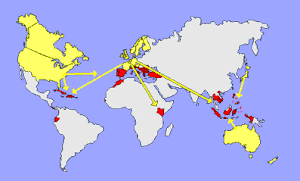
Back নারী যৌন পর্যটন Bengali/Bangla گردشگری جنسی زنانه Persian Tourisme sexuel féminin French תיירות מין נשית HE Wisata seks wanita ID Pelancongan seks wanita Malay महिला यौन पर्यटन Nepali Turismo sexual feminino Portuguese مؤنثی جنسی سیاحت Urdu 女性買春團 Chinese

Countries of origin: Australia, Austria, Belgium, Canada, Denmark, England, Finland, France, Germany, Ireland, Japan, Netherlands, New Zealand, Norway, Scotland, Slovenia, Sweden, United States, UK (Wales).
Countries of destination: Albania, Bulgaria, Cambodia, Croatia, Cuba, Ecuador, Greece, Haiti, Indonesia, Italy, Jamaica, Kenya, Morocco, Philippines, Portugal, Romania, Serbia, Spain, Thailand, Turkey, Vietnam.
Female sex tourism is sex tourism by women who travel intending to engage in sexual activities with one or more locals, including male sex workers. Female sex tourists may seek aspects of the sexual relationship not typically shared by male sex tourists, such as perceived romance and intimacy.[2][3][4][5] The incidence of female sex tourism is much lower than male sex tourism, and the low number of female sex tourists makes it difficult to research this phenomenon, which has been described as "poorly understood".[6][7]
Female sex tourism occurs in diverse regions of the world. Africa, the Caribbean, and southern Europe appear to be preferred destinations for female sex tourists, but some other regions with many unemployed or underemployed locals are also becoming popular.[1] Recent research has suggested that some female sex tourists do not seek male sex workers. A 2018 study found that Australian female sex tourists were more likely to seek female prostitutes than male prostitutes.[6]
Female sex tourists can be grouped into three types:
- Traditional sex tourists, who have similar characteristics and motives as male sex tourists.
- Situational sex tourists, who do not intentionally put themselves in a sex tourist position, but find themselves involved in a sexual encounter with locals. Situational sex tourists may fall into the category of either being businesswomen, students, women in overseas conferences or other women who have different agendas that are non-sexual.[2]
- Romance tourists, who plan to fulfill their travel with romantic experiences that they cannot experience in their native country.[8]
With this movement of different populations to different countries, problems concerning health increase, especially ailments involving sexually transmitted infections (STIs) and HIV/AIDS. Some women involved with sex tourism do not use barrier contraceptives during the majority of their visit, leaving them and those they have sex with unprotected against STIs.[6][9]
- ^ a b "Short-term Lovers". www2.hu-berlin.de. Archived from the original on 20 May 2013. Retrieved 21 November 2018.
- ^ a b Opperman, Martin (1999). "Sex Tourism". Annals of Tourism Research. 26 (2): 251. doi:10.1016/s0160-7383(98)00081-4.
- ^ Hitchcock, Michael (2009). Tourism in Southeast Asia: Challenges and New Directions. NIAS Press. p. 225. ISBN 9788776940348.
- ^ Pearce, Philip; Filep, Sebastian; Ross, Glenn (2010). Tourists, Tourism and the Good Life. Routledge. p. 109. ISBN 9781136930270.
- ^ Matty Silver (February 8, 2013). "Ladies, your holiday romance awaits". Sydney Morning Herald.
- ^ a b c Davy, Zowie; Santos, Ana Cristina; Bertone, Chiara; Thoreson, Ryan; Wieringa, Saskia E. (11 May 2020). The SAGE Handbook of Global Sexualities. SAGE. p. 688. ISBN 978-1-5297-2194-2. "Sex work is a profoundly gendered industry, and most people who buy sex are men, but it is not an exclusively gendered industry. Women who buy sex do exist; however, little is understood about them and if we want to understand the power relations and gender relations sex work involves, we need to pay attention to the practices and motivations of these women. Moreover, while neither the political submissions nor the social commentary referenced in this chapter referred to the transgender sex workers or clients, or a possibility that women might buy sex from providers who are not males, we found all genders participating in commercial sexual services as clients and providers, and further suggest that women in Australia may buy sex more often from female than male providers (Caldwell, 2018)."
- ^ Taylor, Jacqueline Sánchez (2000). "Tourism and 'embodied' commodities: sex tourism in the Caribbean". In Clift, Stephen; Carter, Simon (eds.). Tourism and Sex: Culture, Commerce and Coercion. London: Cengage Learning EMEA. pp. 44–45. ISBN 9781855676367. "One problem with such analyses is that while female sex tourists are a numerically much smaller group than male sex tourists, some women do also practice sex tourism. Social researchers have not been blind to the phenomenon of female sex tourism, yet they have tended to treat it as qualitatively different from male tourism because it's generally true regarding the differences in quality. Both Meisch (1995) and Pruitt and LaFont (1995), who have undertaken research on sex tourism, use the term 'romance tourism' to refer to female sex tourism and imply that it could hold possibilities for positive changes. Female sex tourists are sometimes sympathetically referred to as 'lonely women' whose 'economic and social ability to travel alone is being exploited by Caribbean tourism' and the 'beach boys' or bartenders who either offer the possibility of a 'holiday romance' or sexual harassment."
- ^ Pruitt, Deborah; LaFont (1999). "For Love and Money Romance Tourism in Jamaica". Annals of Tourism Research. 22 (2): 422–440. doi:10.1016/0160-7383(94)00084-0.
- ^ Ragsdale, Kathleen; DifranceiscoI, Pinkerton (April 2006). "Where the boys are: Sexual expectations and behaviour among young women on holiday". Culture, Health and Sexuality. 8 (2): 86–98. doi:10.1080/13691050600569570. PMID 16641059. S2CID 28156493.
© MMXXIII Rich X Search. We shall prevail. All rights reserved. Rich X Search